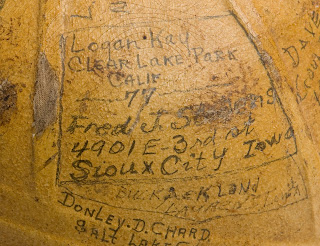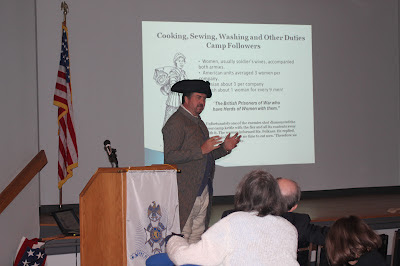Authors Note: My October 2000 article "Massacre on Wake Island" (Navy History Magazine) was the first detailed account of the murder of 98 American civilians by the Japanese in 1943. It has subsequently been used as a reference in several World War II books and articles. In the years since, I have been contacted by scores of people who were related to victims, or are acquainted with family members of the murdered 98. One family member never knew the details of his father's death until he found my article. We were both in tears before that phone call concluded.
In 2011, a descendant of a man who survived the battle and three years as a POW contacted me. I felt privileged that he chose me to tell about his grandfather. Glen Binge's story is remarkable, but the souvenir helmet that returned home with him is even more extraordinary, for it is a memorial to the lives of twenty-seven other men who did not come home.
I wrote about that man and the autographed helmet that he brought home in an article entitled "A Memento of Terror," published by World War II History Magazine in March 2012. This will be an enlarged version of that article. Because of its length, I'll present it in five installments.
 |
| Glen R. Binge was the first to sign his helmet. His is one of the few signatures on the inside. Courtesy Glen Binge Family |
"Dodging Hell in Small Parcels"
Glen Binge brought his helmet home at the end of World War II. The helmet bears the names and addresses of over fifty of his comrades. This was not an unusual thing. Many soldiers kept their helmets as souvenirs. But Glen Binge was not a soldier, or a marine. He was an American civilian who had beaten the odds to survive one of the most famous battles of World War II and three and a half years as a POW in Japan’s most infamous prisoner of war camp. The cloth covered fiber sun helmet that survived and came home with him is a puzzle. How could such a fragile item survive the rigors of combat and a brutal captivity, especially when over half the men who signed it died at the hands of the Japanese? This is the story of the Wake Island men who signed Glen Binge’s helmet.
At fifty-one, Logan Kay was too old to be scrambling through coral gravel dodging Japanese bombs. That is where he found himself on the morning of December 8th, 1941. A force of twenty-seven Japanese bombers struck Wake Atoll within a few hours of the attack against American military installations in the Hawaiian Islands. Wake is 2,300 miles west of Honolulu and across the International Date Line. It was the 8th of December where Logan Kay of Clearlake Park, California and his friend Fred Stevens of Sioux City, Iowa struggled to find shelter. Stevens had a bad case of food poisoning contracted the day before. "Scotty" as his friends called Kay, helped Stevens to a large steel dredge pipe where they would shelter for the next few days.
The Pan American Airways hotel on Peale Island was in shambles. (Wake Atoll is made up three islands: Wake, Peale and Wilkes. The "V" shaped atoll is nine miles long from tip to tip.) Japanese bombs put it out of business and killed ten of its Guamanian staff. The Philippine Clipper floating at the hotel dock, survived the bombing. Soon, all the Caucasian Pan Am employees and five passengers were in the air, fleeing to Hawaii. Jesus "Seuese" Garcia of Agana, Guam acted as spokesman for the surviving thirty-five Guamanian hotel employees who were left behind. They could only stand and watch as the big seaplane winged away. Garcia marched his Chamorros to the island commander to offer their services to defend the atoll.
For the following fifteen days, the Marine garrison on Wake held out against repeated Japanese air and naval attacks. Many of the civilians on the island assisted the Marines in both logistics and combat roles, Logan Kay and Fred Stevens along with them. They were among 1,150 civilian contractors employed by the Morrison-Knudsen Company, part of a cooperative of eight construction companies called the Contractors Pacific Naval Air Bases (CPNAB). The CPNAB was contracted to build an airfield, seaplane base, and submarine base and to dredge a channel into the lagoon to allow access for submarines.
 |
| Wake Island is 2,300 miles west of Hawaii. Map from USMC History of the Battle of Wake Island http://www.ibiblio.org/hyperwar/USMC/USMC-M-Wake.html#VII |
The garrison endured daily air attacks and on December 11th repelled a naval and amphibious assault with its heavy seacoast guns. A larger, more determined invasion force arrived two days before Christmas and the well-trained force of Japanese Special Landing Force troops finally overwhelmed the garrison after heavy fighting. In the dawning hours of 23 December 1941, the Japanese captured 1,621 Americans with the fall of the atoll.
"Come out and give up. The Island was surrendered at seven-twenty this morning." Twenty three year old carpenter, Rodney Kephart heard the call from his hiding place. Kephart, from Boise Idaho, assisted in defense of the island during the long siege by tending the wounded and digging trenches. He admitted after the war, "It certainly was a relief to be free from the suspense of it all, and to be through dodging hell in small parcels."
 |
| Rodney Kephart circa 1999. His story can be found here: http://home.comcast.net/~winjerd/Kephart.htm |
“The Emperor has gracefully presented you with your lives”
As resistance ceased on Wake, the U.S. Marines, sailors, and contractors were marched to the runway and seated in rows facing a line of Japanese machine guns. Logan Kay and Fred Stevens were the only men who avoided capture. They hid in the bush certain that those surrendering were to be murdered. Indeed, this was the plan of the Japanese troops who held them. Only the intervention of Rear Admiral Sadamichi Kajioka, who commanded the invasion force, prevented the slaughter. After Kajioka arrived, an interpreter read a proclamation to the prisoners that said, in part: "The Emperor has gracefully presented you with your lives." An unknown voice bellowed from the crowd of Americans: "Well, thank the son-of-a-bitch."
Go to this page to see letters from family members who responded to this blog article - http://erasgone.blogspot.com/2013/03/history-that-tugs-at-heart.html
You can see a complete listing of all the names of Glen Binge's Sun Helmet at this link: https://sites.google.com/site/markehubbs/home/names-on-the-wake-island-sun-helmet





























